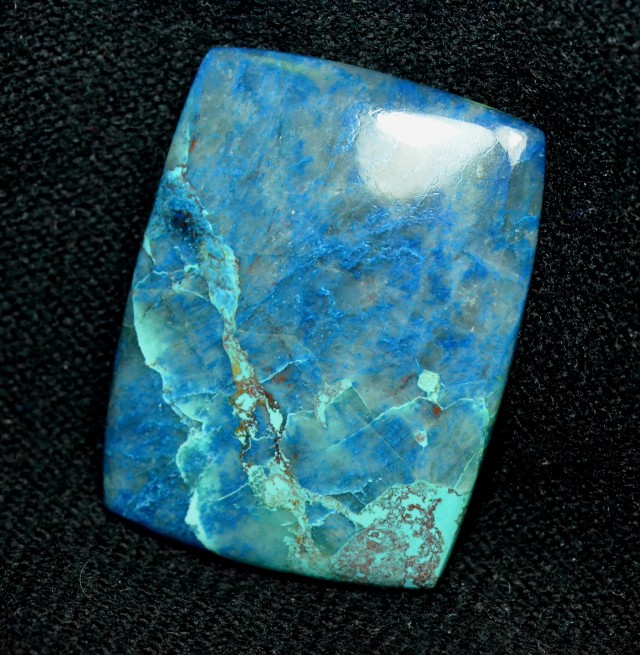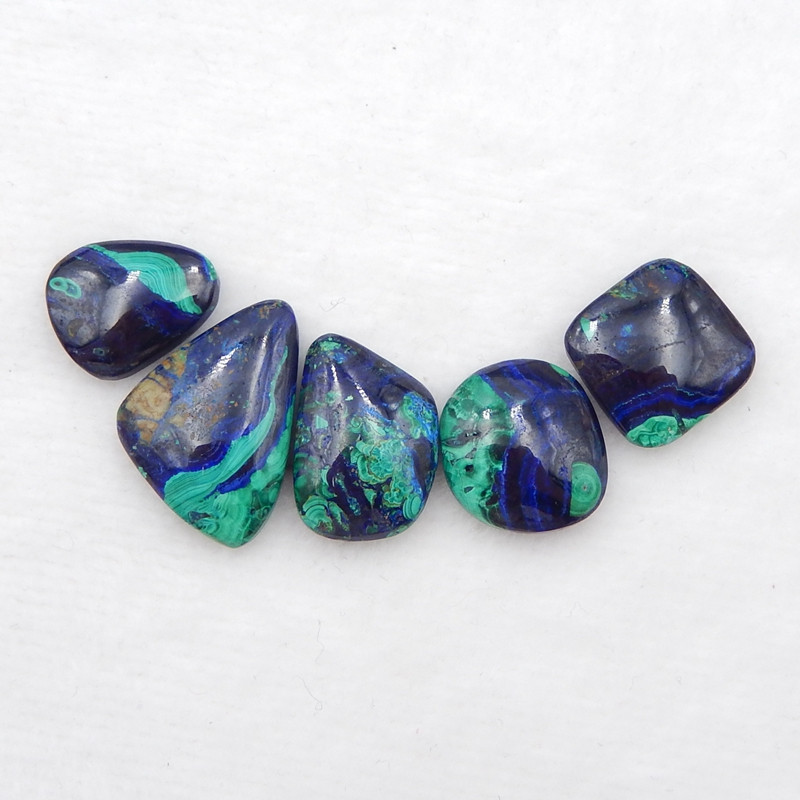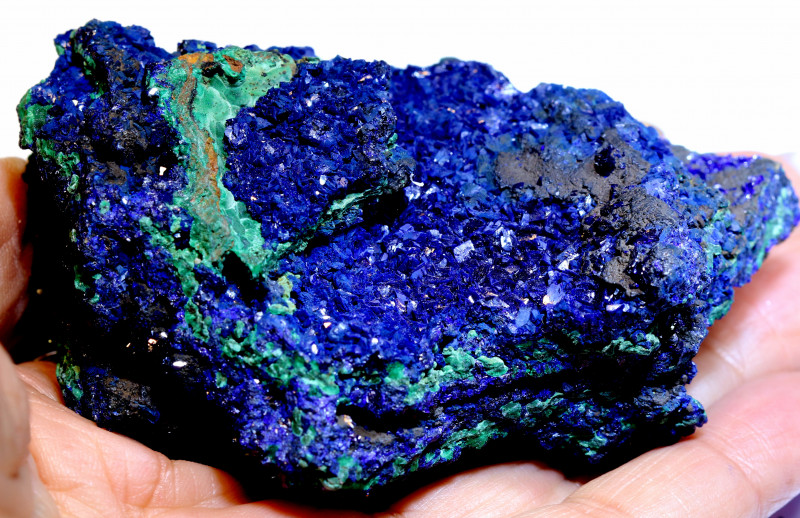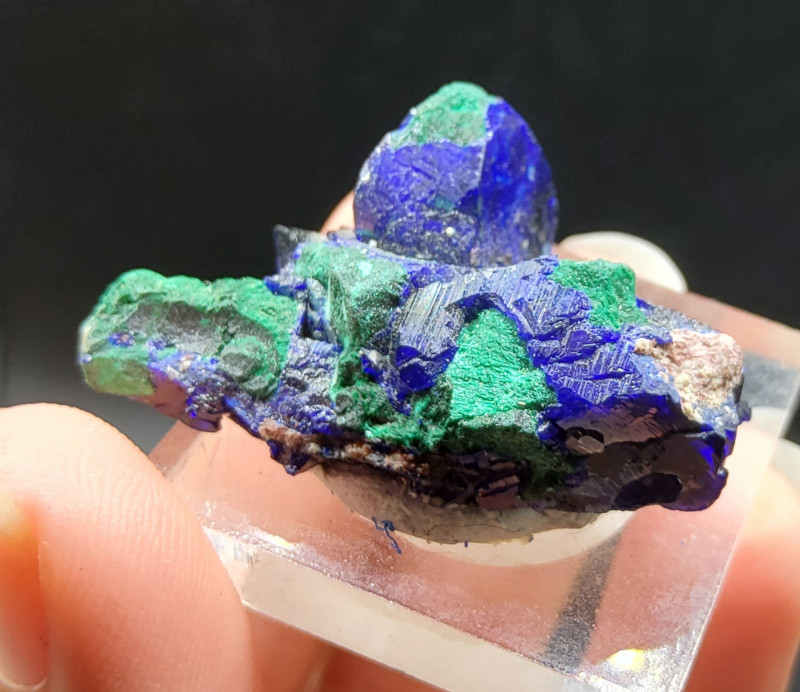
Azzurrite: proprietà, significati, valore e altro
 L'azzurrite è un minerale carbonato di rame blu, noto per il suo colore vibrante e la sua lunga storia nelle arti. La vivida tonalità cobalto della pietra ha spinto gli artisti a macinarla per ottenere colori e tinte per secoli, e il suo colore è visibile in alcune delle opere d'arte più famose al mondo.
L'azzurrite è un minerale carbonato di rame blu, noto per il suo colore vibrante e la sua lunga storia nelle arti. La vivida tonalità cobalto della pietra ha spinto gli artisti a macinarla per ottenere colori e tinte per secoli, e il suo colore è visibile in alcune delle opere d'arte più famose al mondo.
Due importanti artisti del Rinascimento che utilizzarono il pigmento azzurrite sono Raffaello e Hans Holbein il Giovane.
La pala d'altare Madonna col Bambino in trono e santi del pittore italiano Raffaello presenta il blu azzurrite nel velo della Madonna, sebbene l'azione degli agenti atmosferici abbia sostituito il blu azzurrite con un pigmento verde malachite.
L'artista tedesco Hans Holbein il Giovane utilizzò il pigmento azzurrite per lo sfondo blu del suo ritratto Dama con uno scoiattolo e uno storno , che probabilmente raffigura Anne Lovell, moglie dello scudiero di Enrico VIII.
Tuttavia, il significato dell'azzurrite si estende ben oltre il mondo dell'arte. In questa guida, vi spiegheremo tutto ciò che c'è da sapere sulla pietra azzurrite, da come può essere utilizzata per scopi curativi a cosa contribuisce al suo valore.
Cos'è l'azzurrite?
L'azzurrite è un'antica pietra semipreziosa che riflette i cangianti toni blu del cielo. Spesso, l'azzurrite mostra il blu intenso e profondo del cielo al tramonto, simile alla Notte stellata di Van Gogh.
I nati sotto il segno del Sagittario sono onorati con una pietra zodiacale: l'azzurrite! Oltre a questa gemma azzurra che richiama la malinconia invernale, le proprietà metafisiche dell'azzurrite incoraggiano l'intellettuale Sagittario a immergersi nella sua passione per la conoscenza.
Spesso, l'azzurrite si mescola con il suo simile carbonato di rame per creare una combinazione di azzurrite e malachite. La nuova pietra, chiamata azzurmalachite, è perfetta per i nostri amici dell'Acquario!
Oltre alla somiglianza dell'azzurmalachite a un globo, indossare gioielli in azzurrite malachite può far emergere i tratti umanitari dell'Acquario, incoraggiando il suo impegno nel migliorare il mondo.
Caratteristiche minerali
L'azzurrite è uno dei pochi minerali basici di carbonato di rame sulla Terra, unito solo alla malachite . L'azzurrite è meno stabile della malachite e l'azione degli agenti atmosferici spesso la trasforma in malachite.
L'azzurrite può formarsi come drusa , una crescita cristallina contenente molti minuscoli cristalli riflettenti che brillano come lo zucchero. L'azzurrite può crescere all'interno di altri cristalli, in particolare di malachite e crisocolla .
Una varietà di crisocolla degna di nota contenente azzurrite è la "Parrot Wing", una gemma mista ad azzurrite, diaspro e quarzo . La famosa pietra di Eilat, in Israele, mescola crisocolla con azzurrite, malachite e turchese.
Nella scala di durezza di Mohs , i minerali di azzurrite si classificano tra 3,5 e 4. Per ulteriori dettagli scientifici sull'azzurrite, consulta l'elenco qui sotto!

Specifiche e caratteristiche dell'azzurrite
Colore: azzurro in varie tonalità
Struttura cristallina: monoclina
Lucentezza: vitrea (simile al vetro) a opaca
Trasparenza: il più delle volte opaca; raramente traslucida o trasparente
Indice di rifrazione: 1,72-1,84
Densità: 3,7-3,9
Scollatura: Perfetta su [011]; Discreta su [100]; Scarsa su [110]
Frattura: concoide
Striscia: Azzurro chiaro
Pleocroismo: Presente e forte; Sfumature blu
Partendo dalla mineralogia, cosa dovremmo sapere sul significato del cristallo di azzurrite?
Significato della pietra azzurrite
La gemma azzurrite ha diversi soprannomi, tra cui lapis armenus, azurium citramarinum e il suo primo nome: lajevard. Il termine lajevard è un antico termine persiano che indica un'area della penisola arabica nota per le sue gemme azzurro-blu.
Avete mai sentito parlare del lapislazzuli ? Azzurrite e lapislazzuli prendevano entrambi il nome dalla zona di Lajevard. Conosciuto in arabo come lazaward , il termine latino prese poi il sopravvento, diventando lapislazzuli , ovvero "pietra azzurra".
Nei circoli spirituali moderni, l'azzurrite simboleggia la saggezza, la guarigione e l'intuizione.
Le società antiche associavano l'azzurrite alla rivelazione dei misteri celesti. Il soprannome dell'azzurrite "Pietra del Cielo" deriva dalle antiche credenze cinesi che la vedevano come un portale tra cielo e terra.
Popoli indigeni come i Maya e i nativi americani collegavano il significato dell'azzurrite alle capacità psichiche. I Maya consideravano l'azzurrite uno strumento per ricevere saggezza dal regno spirituale, mentre i nativi americani la usavano per entrare in contatto con le guide spirituali.
Nella mitologia greca, l'azzurrite è associata ad Atena, dea della guerra e della saggezza. I miti egizi associano l'azzurrite a Iside, dea della vita che simboleggiava la guarigione e l'intuizione, tra gli altri poteri.
Gli Egizi credevano anche che l'azzurrite fosse collegata al giovane dio del cielo Horus e talvolta usavano la pittura azzurra per dipingere l'occhio di Horus sulla loro fronte per proteggersi.
Conosciamo gli usi antichi, ma oggi a cosa serve l'azzurrite?

Proprietà curative dell'azzurrite
Le vibrazioni elettriche presenti in ogni pietra preziosa le rendono utili cristalli curativi . Le proprietà curative dell'azzurrite ruotano attorno alla liberazione dei sentieri bloccati e alla promozione del flusso della conoscenza.
Come altre pietre preziose blu , l'azzurrite blu possiede intrinsecamente proprietà che migliorano la concentrazione, la fiducia e l'intuizione.
Che tipo di guarigione specifica si può praticare con le pietre preziose di azzurrite?
Guarigione fisica
Le proprietà curative dell'azzurrite possono agire sulla parte superiore del corpo, alleviando dolori a gola, spalle e collo. Si dice che la pietra migliori la circolazione sanguigna e riduca le vertigini.
L'azzurrite è comunemente usata per l'allineamento, in particolare per la colonna vertebrale o le articolazioni. La capacità della pietra di liberare i canali nervosi può essere sfruttata per aumentare le connessioni neurali che conducono al cervello, rallentando così gli effetti dell'invecchiamento sull'agilità mentale.
Guarigione Emotiva
Se lotti contro la sensazione di inferiorità, insicurezza o inadeguatezza, l'azzurrite è qui per aiutarti. Emotivamente, le proprietà metafisiche dell'azzurrite possono dissipare il dialogo interiore negativo e la bassa autostima.
In caso di tensione nelle relazioni, che siano familiari, romantiche o amichevoli, l'azzurrite può fornire chiarezza sulla radice del problema. Una volta affrontata la fonte, l'azzurrite può incoraggiare un dialogo aperto e onesto, così che tu e la persona cara possiate procedere verso la guarigione.
Guarigione dei chakra
Più interessato alla guarigione dei chakra? Puoi usare l'azzurrite per riequilibrare il chakra del terzo occhio! Il chakra del terzo occhio, o chakra della fronte, è incentrato su una comprensione superiore, dove vediamo il mondo e noi stessi con accettazione e consapevolezza.
Quando il terzo occhio non è in equilibrio, potremmo sentirci controllati dalle nostre reazioni negative, bloccati in uno stato di irrequietezza e inattività. Tenere o indossare gioielli di azzurrite vicino al chakra, come orecchini di azzurrite, può riequilibrare il terzo occhio e permetterci di fare ciò che ci piace senza sentirci frenati.
Pronti a iniziare a curarvi con l'azzurrite? Prima di acquistarne una, leggete i nostri consigli per assicurarvi di acquistare un'azzurrite di buona qualità.

Proprietà della pietra preziosa azzurrite
Ogni esperto o collezionista di gemme sa che il valore di ogni pietra dipende dalle sue proprietà, caratteristiche che gli esperti utilizzano per determinarne la qualità.
Quando si acquista l'azzurrite, le caratteristiche da tenere a mente sono il colore, il taglio, il peso in carati e i trattamenti.
Colore
Il colore dell'azzurrite è sempre blu, sebbene possa apparire pallido, vivace o scuro. I cristalli di azzurrite più grandi sono solitamente di un blu intenso, mentre i cristalli più piccoli possono essere più chiari a causa dell'esposizione agli agenti atmosferici.
Quando si mescola con la malachite, questa conferisce delle brillanti macchie verdi allo sfondo blu dell'azzurrite. La pietra combinata, nota come azzurmalachite, può anche essere a bande. Curiosamente, il rame è la causa del blu dell'azzurrite e del verde della malachite.
Taglio
La durezza dell'azzurrite, la sua perfetta sfaldatura e la sua sensibilità al calore rendono il taglio della pietra difficile. L'azzurrite sfaccettata è rara e si ottiene solo con cristalli di piccole dimensioni. Per evitare rotture, l'azzurrite sfaccettata viene spesso utilizzata su gioielli più resistenti agli urti, come orecchini e pendenti.
L'azzurmalachite viene tagliata più comunemente dell'azzurrite da sola, poiché la malachite ne aumenta la durevolezza. Tuttavia, i gioielli in azzurmalachite sono meno comuni dei cabochon o delle sculture in azzurmalachite.

Peso in carati
L'azzurrite grezza si trova solitamente in esemplari massicci o nodulari, e i cristalli di qualità pari a quella delle gemme sono rari. Qualsiasi cristallo di azzurrite sfaccettato sarà in genere lungo meno di 2 cm.
Gli esemplari di azzurrite di grandi dimensioni sono solitamente di colore più scuro. I gioiellieri spesso li usano per creare cabochon di azzurrite. Tuttavia, l'azzurrite massiccia è solitamente una miscela di azzurrite e malachite, che molti gioiellieri intagliano in perle o oggetti decorativi per mettere in risalto gli intricati motivi cromatici della pietra.
Trattamenti e Sintetici
L'azzurrite viene raramente trattata con coloranti o calore, ma rivestimenti e riempimenti sono comuni. In genere, i riempimenti vengono impiegati per conferire alla pietra una maggiore stabilità. Per migliorare la lucentezza dell'azzurrite, la pietra può essere rivestita superficialmente con cera o resina.
L'azzurrite sintetica è apprezzata dai geologi come campione scientifico e dai pittori come pigmento economico. Per le pietre preziose, l'azzurmalachite sintetica o ricostruita è più diffusa, ottenuta impregnando l'azzurmalachite compressa con plastica per l'uso in gioielli o cabochon.
I procedimenti per creare sinteticamente l'azzurrite hanno avuto inizio secoli fa e hanno svolto un ruolo cruciale nella storia di questa pietra preziosa.

Storia dell'azzurrite
L'uso dell'azzurrite risale all'antico Egitto, dove si creava il pigmento "blu egizio" dalla polvere di azzurrite. Il famoso naturalista greco antico Plinio il Vecchio scrisse dell'azzurrite usando il greco kuanos o il latino caeruleum , entrambi significanti "blu intenso".
Anche l'Asia orientale vanta una buona dose di dipinti in azzurrite, tra cui antiche pitture rupestri nella Cina occidentale e numerosi dipinti murali risalenti al XV-XVIII secolo, conservati nei palazzi e nei monasteri tibetani.
Dal Medioevo al Rinascimento, l'azzurrite è stata la principale fonte europea di pigmenti blu. La maggior parte delle azzurriti europee proveniva dalla Francia.
La Francia vanta uno dei primi giacimenti di azzurrite più significativi, situato a Chessy. Il giacimento diede origine al nome commerciale francese dell'azzurrite, chessylite.
Nel XVIII secolo, il pigmento artificiale utilizzato per creare i colori blu sostituì l'azzurrite naturale, poiché il nuovo pigmento era più uniforme, economico e facile da lavorare.
Sebbene l'azzurrite non abbia una lunga storia come pietra preziosa, alcuni gioiellieri hanno sfruttato il suo splendido colore.
Una di queste persone è David Webb, un rinomato gioielliere americano noto per aver creato gioielli per clienti di alto profilo come Elizabeth Taylor e Barbra Streisand.
Webb incorporò azzurrite e azzurmalachite nella creazione di anelli in azzurrite intagliati o tempestati di diamanti. Alcuni dei pezzi di Webb sono ancora all'asta, come uno splendido anello in azzurrite e malachite degli anni '70.
Come si forma l'azzurrite prima di trasformarla in splendidi pezzi?

Origini e fonti della pietra azzurrite
L'azzurrite si forma nei giacimenti di rame come minerale secondario. Un minerale secondario è un minerale che si è trasformato da un minerale (minerale primario) in un nuovo minerale a causa dell'azione degli agenti atmosferici.
La formazione della gemma di azzurrite avviene attraverso l'interazione tra acqua ricca di anidride carbonica e minerale di rame. La soluzione fa sì che il minerale di rame si dissolva gradualmente man mano che l'acqua evapora lentamente, lasciandoci l'azzurrite.
Spesso i minatori cercano azzurrite e/o malachite per sapere se un giacimento contiene quantità sostanziali di rame.
La malachite nelle miniere di azzurrite potrebbe non essere nata come malachite. L'azzurrite è uno pseudomorfo della malachite, il che significa che a volte si trasforma in malachite. Quando avviene questa trasformazione, l'azione degli agenti atmosferici fa sì che le molecole d'acqua sostituiscano le molecole di anidride carbonica, dando origine alla nuova pietra.
Una volta formata, dove si trova l'azzurrite?
Luoghi di estrazione mineraria
Oggi, i giacimenti di azzurrite più importanti si trovano negli Stati Uniti, in Francia e in Australia. Le miniere statunitensi più produttive si trovano in Arizona, Utah e Nuovo Messico.
Dove altro si può trovare l'azzurrite?
Cina
Congo
Inghilterra
Germania
Grecia
Italia
Messico
Marocco
Namibia
Pakistan
Perù
Russia
Slovacchia
Ora parliamo di prezzo. Quanto costa l'azzurrite?

Prezzo e valore dell'azzurrite
Nonostante i numerosi luoghi in cui è possibile trovare l'azzurrite, il minerale in sé non è abbondante. Tenetelo a mente quando valutate il suo valore.
Poiché l'azzurrite pura è la forma più rara, è anche quella con il costo più elevato. Piccoli esemplari di azzurrite pura, grezzi o burattati, di solito costano almeno dai 20 ai 50 dollari. Anche l'azzurrite grezza, se pura, può costare oltre 10.000 dollari.
È più probabile trovare la malachite mescolata con un minerale di azzurrite, il che riduce notevolmente il costo di quest'ultima.
L'azurmalachite grezza costa solitamente tra 0,40 e 1 dollaro al carato a prezzi all'ingrosso. Un cabochon di malachite e azzurrite costa in genere circa 1 dollaro al carato.
Cura e manutenzione dell'azzurrite
Per pulire l'azzurrite, consigliamo di utilizzare un panno morbido per strofinare delicatamente la superficie. È possibile utilizzare acqua fredda, ma è importante evitare l'uso di detergenti acidi.
Come un amato animale domestico, l'azzurrite, purtroppo, invecchia più velocemente di noi. Il colore può sbiadire sotto la luce intensa e persino all'aria aperta. Sotto il calore, l'azzurrite perde completamente il suo colore e la sua struttura, trasformandosi in polvere nera.
Assicuratevi di rimuovere i gioielli in azzurrite quando svolgete attività fisica o se vi trovate alla luce diretta del sole. Per motivi di sicurezza, non lavorate mai su campioni di azzurrite senza dispositivi di protezione, poiché l'inalazione di polvere di rame è pericolosa.
Sentiti celestiale con l'azzurrite!
Ecco fatto sull'azzurrite! Con la sua tonalità intensa e le sue innumerevoli proprietà curative, non c'è da stupirsi che sia chiamata la "Pietra del Paradiso".
Chiunque porti con sé una gemma di azzurrite o indossi un braccialetto di azzurrite sentirà sicuramente le vibrazioni celestiali della pietra!
Cerca il Gemstone Encyclopedia
Aste correlate
articoli Correlati
Ognuno di noi ha una pietra preziosa che corrisponde al proprio segno zodiacale. Queste pietre sono anche note come la tua Pietra Stellare. Scopri di più su queste pietre e qual è la tua Pietra Stellare.
10th May 2018
In origine, le pietre portafortuna o gemme erano associate a un segno zodiacale o al mese di nascita di un individuo. Scopri qual è la tua pietra e guarda le pietre che abbiamo in vendita.
8th Feb 2021
Esistono moltissimi strumenti sul mercato per testare una pietra preziosa, ma quali sono i principali strumenti necessari per un'analisi semplice? Diamo un'occhiata a quattro strumenti per testare le pietre preziose.
4th Mar 2020
Articoli Recenti
Le sculture in avorio di palma, chiamato anche avorio vegetale, sono un'alternativa naturale all'avorio di elefante, ricavato in modo etico dalla noce della palma sudamericana Phytelephas. Scopri tutto sull'avorio di palma in questa guida!
15th Jan 2026
Le pietre a forma di fiore di crisantemo sono meraviglie naturali caratterizzate da un motivo floreale di calcite bianca, celestina o andalusite incastonato su calcare nero o argillite.
13th Jan 2026
La pietra del sole a reticolo arcobaleno è una varietà di feldspato con tre splendidi effetti ottici dovuti alla presenza di varie inclusioni. La sua colorazione infuocata e il suo motivo a reticolo la rendono una gemma rara da collezione!
12th Jan 2026
Categorie di articoli
How To's is where you will find helpful articles from gem Rock Auctions on how to cut gemstones, select gemstones and buy gemstones.
9 Articoli





